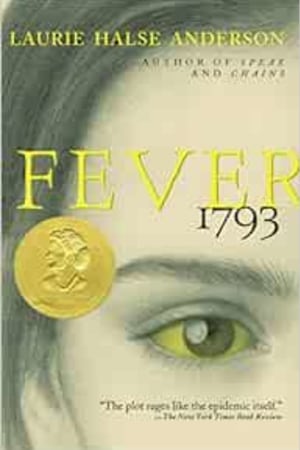Historical Fiction
- Publisher : Simon & Schuster Books for Young Readers; Reprint edition
- Published : 01 Mar 2002
- Pages : 272
- ISBN-10 : 0689848919
- ISBN-13 : 9780689848919
- Language : English
Fever 1793
An epidemic of fever sweeps through the streets of 1793 Philadelphia in this novel from Laurie Halse Anderson where "the plot rages like the epidemic itself" (The New York Times Book Review).
During the summer of 1793, Mattie Cook lives above the family coffee shop with her widowed mother and grandfather. Mattie spends her days avoiding chores and making plans to turn the family business into the finest Philadelphia has ever seen. But then the fever breaks out.
Disease sweeps the streets, destroying everything in its path and turning Mattie's world upside down. At her feverish mother's insistence, Mattie flees the city with her grandfather. But she soon discovers that the sickness is everywhere, and Mattie must learn quickly how to survive in a city turned frantic with disease.
During the summer of 1793, Mattie Cook lives above the family coffee shop with her widowed mother and grandfather. Mattie spends her days avoiding chores and making plans to turn the family business into the finest Philadelphia has ever seen. But then the fever breaks out.
Disease sweeps the streets, destroying everything in its path and turning Mattie's world upside down. At her feverish mother's insistence, Mattie flees the city with her grandfather. But she soon discovers that the sickness is everywhere, and Mattie must learn quickly how to survive in a city turned frantic with disease.
Editorial Reviews
School Library Journal starred review Readers will be drawn in by the characters and will emerge with a sharp and graphic picture of another world.
The New York Times Book Review A gripping story about living morally under the shadow of rampant death.
VOYA A vivid work, rich with well-drawn characters.
The New York Times Book Review The plot rages like the epidemic itself.
The New York Times Book Review A gripping story about living morally under the shadow of rampant death.
VOYA A vivid work, rich with well-drawn characters.
The New York Times Book Review The plot rages like the epidemic itself.
Readers Top Reviews
Whitney ReinhartJ
Apparently, Fever 1793 by Laurie Halse Anderson spurred some middle schools to have "Yellow Fever Days" after it was published in 2011? While I can't speak to that from personal experience, I can see the value in bringing history to life for the YA crowd. I readily admit, I didn't realize Fever was a YA book until after I was invested in the narrative. And by invested, I was hooked. Our young heroine, Mattie, struggles beneath the restrictions of her overprotective mother and seeks shelter in the indulgence of her grandfather as they work to keep the family coffee house afloat in post-colonial Philadelphia. Mattie's journey to independence and discovery of her own personal strength starts when she learns of the untimely death of a friend, Polly. It isn't long before the Yellow Fever is running rampant through the streets of the city, leaving Mattie and her family to make difficult decisions about survival. Worth the read for any American History middle grade students you might know.
JessicaWhitney
My daughter had to choose an award winning book for a book project. I chose this one for her. She is not my reader at 11 years old. Has never really enjoyed reading (probably because she hadn't found books she enjoyed yet). She couldn't put this book down. She had a great time reading it and presenting her project for her reading class. I also read it with her - I highly recommend this book.
AnnetteBReviews
“The yellow fever outbreak that struck Philadelphia in 1793 was one of the worst epidemics in United States history. In three months it killed nearly five thousand people, 10 percent of the city’s population.” Philadelphia, 16 August 1793. Matilda Cook lives with her mother and grandfather above their coffeehouse. Today, before the day is in full swing with their chores, they learn that they lost Polly, their serving girl, to fever. It happened very quickly, in a matter of hours. “A week later, sixty-four people had died.” The grandfather is skeptical about all those deaths being blamed on fever. He insists, “Even a few hundred isn’t enough to call it an epidemic.” “There are forty-thousand people living in Philadelphia.” Half of them left the city. Over three thousand are dead. “Those who don’t die of the fever are beginning to starve.” Matilda, a dreamy girl, now needs to learn how to survive the plague. Loved the character of Matilda. She is so opposite of her mother, who is a very hard worker and that’s what distinguished her from the early childhood. Matilda pours her thoughts how she feels about it. The rage of fever is very real. “Bodies are piling up like firewood.” The doors are shut in your face as each family tries to stay alive behind their own walls. “The streets were ghosted, colorless and hushed.” Except lonely children without their mothers and thieves breaking into empty houses. Loved the atmosphere of the coffeehouse, filled with “gentlemen, merchants, and politicians enjoying a cup of coffee, a bite to eat, and the news of the day.” Matilda’s grandfather, former army officer, is “the heart of all gossip and tall tales in the coffeehouse.” He is quite a character, which I enjoyed very much. The storyline and the writing are very impressive. The plot is engrossing, moving the story forward as fast as the rage of epidemic.” Historical fact, “In a few short weeks the city was transformed into a living nightmare, with the sick dying, the healthy paralyzed with fear, and the doctors helpless. (…) The brave people who stayed in the city and helped the sick were extraordinary.”


